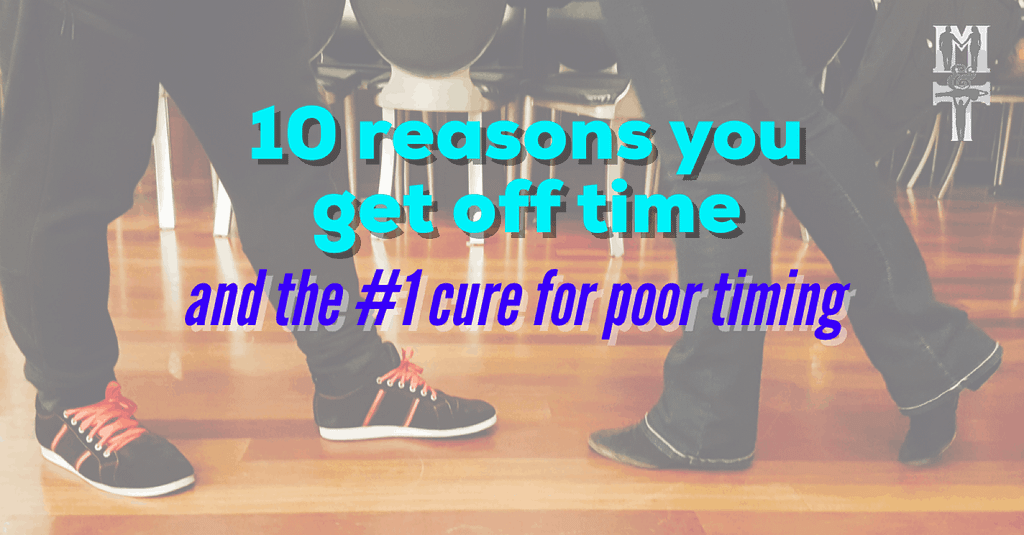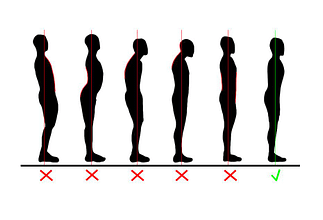No products in the cart.

10 Reasons you get off time and the #1 way to cure poor timing
Reading Time: minutes remaining
Do you hear feedback from teachers and judges that you need to work on your timing? Or maybe you can feel you're off time a lot but don't know how to fix it?
Being off time could be referring to 10 or more different issues. Whenever a teacher or judge tells you you are off time, you need ask them to elaborate so you know where the problem is. Without knowing the specific issue, you can’t effect change.
So, let’s look at the top 10 causes that are producing the effect of you “being off time”. Some will be familiar and obvious, but some might be surprises to you – you might not realize that they have anything to do with timing. These are the sneaky ones you owe it to yourself to investigate further.
Afterwards, I’ll elaborate on the #1 reason that the majority of dancers get off time, and give you specific tips on exactly how to see an improvement – TODAY!
“Being off time” can be referring to personal movement or partnership movement. You can have impeccable timing in your own steps, but be horribly pulling your partner off time. Similarly, you could have amazing timing in your connection and partnership, but not able to step on time.
When troubleshooting, we always look at personal movement skills first, then partnership movement skills, because usually the former affects the latter.
Personal Movement Skills
1. Not physically hearing the beat
How this puts you off time: Hard to step on the beat when you can’t hear it! Physically not being able to detect a distinct beat – this often happens in the intro of songs. This is a common skill error that is easily trained. You might use this as an excuse, but only a small percentage of the population are technically deficient in this sensory ability.
2. Not understanding the difference between upbeat & downbeat
How this puts you off time: Assuming that every beat is equal, and not realizing that you need to pick an odd beat to start patterns. You randomly start patterns on whatever beat is convenient, without regard for the meter or your partner.

3. Not shifting weight to be able to start in time to step on the beat
How this puts you off time: It is nearly impossible to begin a movement from standing still and trying to start your movement at the same time as the beat. This will inevitably put you 1/2 to a full beat behind. Much easier to time your movement while already in motion.
4. Poor pitch
How this puts you off time: Being pitched backward from the hips, or straight upright are both not conducive to mobility. These positions lock up your hip and leg muscles, making foot articulation and balance much harder. (see video below)

5. Missing/incorrect foot articulation (foot rolling)
How this puts you off time: Shuffling, digging, or splatting your feet does not allow you to control how fast or slow you arrive on each step. This often results in stepping all at once, too quickly, stopping movement between steps, which causes either a lag or a balance issue and falling off balance.
6. Anchoring incorrectly
How this puts you off time: You think you are anchoring, but you’re not: you do a triple, but your weight doesn’t shift completely, resulting in falling off of that foot and rushing into the 1.
7. Off balance
How this puts you off time: If you are falling from one foot to the other, you are not able to control the timing of each footfall, or the duration of time spent on each foot. You also will not be stable for your partner to rely on. (see video below)
Partnership Movement Skills
8. Incorrect elasticity
How this puts you off time: You think you are stretching in your anchor, but you’re not. Because of overly engaged biceps, your elbow is locked, which causes your hand to move in the same direction as your centre, technically leading at the time you think you are stretching, which is 1/2 beat to a full beat early.
9. Restarting incorrectly after deceleration or stop
How this puts you off time: Your timing was great going into a musical deceleration, but you either rushed the ending, failed to find the beat again before restarting, or did not position yourself or your partner to transition properly.

10. Being pulled off by a strong partner
How this puts you off time: As a leader, if your follower is strong/heavy, if you use your usual quantity of force to generate momentum, you will be too slow. As a follower, unless you make adjustments to compensate, a strong leader pulling you early is going to leave you no choice but to step off time.
The #1 reason dancers are off time (and how to fix it)
The #1 reason dancers are off time is a personal movement skill: because they are off balance. Balance control can be drastically improved by training your pitch and foot articulation.
So here is an 8-step skill progression you should do IN SEQUENCE so you can start to see results today.
The convenient perk to training your balance control, is that it actually improves other skills that will take you to the next level, so even if you don’t have a major timing issue, you will benefit from these exercises.
This is not a quick fix! It is not even close to enough to say “just have better pitch and remember your foot rolling”. In the Swing Literacy Dancer Development Program, we go into a lot more detail on the progressive skill development and drills need to actually focus on these topics.
But here’s a quick prescription you can do at home to improve your timing TODAY:
1. Check in with your pitch.
Avoid standing with your chest sunken back and your pelvis forward. Also avoid standing bolt upright with butt squeezed/tucked under. Instead, assume a sport-ready position, then straighten your knees until you are almost standing up. You should be able to pedal your knees freely. This is your most mobile position and is easily felt when you walk up a set of stairs. See video below:
2. Walk backward to discover how to roll naturally
As you walk backward normally, note that your toe is the first part of your foot to touch the floor. After the toe, your ball of foot touches, then you imagine your arch touching, then your heel, then your knee straightens. Use these 5 parts of the foot to take every step: Toe-ball-arch-heel-knee. Notice that the weight transfer is gradual: each segment of the foot takes more % of your weight: 20-40-60-80-100. The foot rolling you want for your WCS is the same. Try to keep the same technique of gradual weight transfer through each segment as you stop travelling and just roll in place. Repeat.
Watch for errors of “splatting” your toes and ball at the same time, or applying too much pressure to the forefoot (“massaging” or “digging” into the floor) which will cause foot injuries and inhibit your agility. See video below:
3. Practice this rolling in every direction *except* forward.
Walking forward should feel very ergonomic and natural, with a heel strike (for now). You can visualize each of the segments of your sending foot “peeling” off the floor as gradually as they “rolled” down before.
4. The Bee Drill
This is a drill with many layers/levels. To start, think of how an insect (bee) flies around the room randomly in any direction. Start stepping around the room in random directions, changing directions often, trying to avoid stepping in any recognizable pattern. Every step you take should be a quality rolling step.

5. Bee Drill variation #1
Use triple step timing (quick-quick-slow). Don’t cheat your roll on the quicks. The “slow” roll should last twice as long as a quick roll. Slow down your roll by flexing your foot and ankle muscles to prevent your heel from collapsing to the floor too early.
6. Bee drill Variation #2
Use 6-count timing, but put on a song that is less than 80bpm.
7. Bee drill variation #3
Sing Happy Birthday to yourself. Allow yourself to step only on each syllable. If your steps are out of sync with your lyrics, you are “off time”. Use your foot and leg muscles to control your timing so you can get back on time.
8. Bee drill variation#4
If you can handle the movement solo while maintaining good foot rolling, try adding a variable of holding a cup of water in your partnering hand. This helps remind you to manage your connection.
Looking for more skill progressions like this?
There's WAY more where these came from!
These are only 8 of hundreds of drills we have conveniently sequenced into progression ladders to build skills faster in areas such as footwork, turns, musicality, connection, and more.
This is the type of accessible, technical detail that you deserve and we supply in the Swing Literacy Dancer Development Program.
Click below for more info:
You must be logged in to post a comment.




that’s brillant! Thank you so much 🙂
I can’t imagine about this example and exprenations →Not understanding the difference between upbeat & downbeat
How this puts you off time: Assuming that every beat is equal, and not realizing that you need to pick an odd beat to start patterns. You randomly start patterns on whatever beat is convenient, without regard for the meter or your partner.
モーメンタムに行ったあとに理解しました!!
I'm so glad to hear that the Momentum membership for alumni is helping you master your weight transfers and timing!
thanks for this
SUPER TOP TIPS!
Incredibly useful "small talk" to dance.
I love to walk backwards and practice my turnout and rolling articulation in the sand. Hard to move too fast and easy to pay attention to minute weight changes.
cool!
Using the staircase to experience a correct posture is an amazing idea. Thank you so much for this wonderful tip.
I did each drill 5 times. Must do some each day for a few mins